”Hi, my name is Francis. I am your travel guide to the roots of the London Underground and to the origins of the names of all stations currently in use. This is the third stake of our journey. Relax and welcome! Here are the stations from Fairlop to Hyde Park Corner.”
FAIRLOP
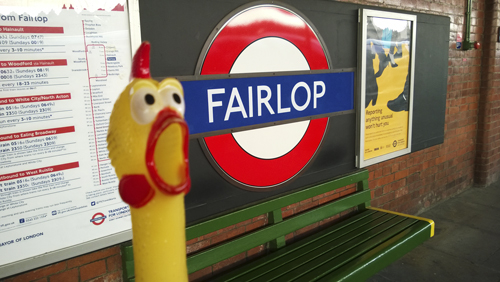
A legend surrounds the name of Fairlop. In the early part of the 19th century there was a fine oak tree here, which sheltered a long-established fair founded by a certain Daniel Day. When Day died in 1767, his friends, after much consideration, decided to make his coffin from the tree and as the tree continued to flourish, they agreed that they had made a fair lop. A little fanciful perhaps, but the name is derived from fair and the Modern English lop, ’a small branch or twig’, and means ’the beautiful trees with their leafy branches’ which stood nearby.
The station was opened as Fairlop by the Great Eastern Railway on 1 May and first used by Underground trains on 31 May 1948.
FARRINGDON
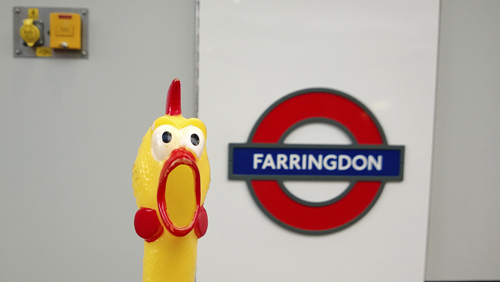
This part of central London takes its name from Farrington Street. In 1279 the City merchant William de Farindon of Goldsmisth’s Company purchased the ’ward’ of this area and became an Alderman of it two years later; the street was named in his honour. The street was built in 1738 upon arches, above the old River Fleet which is now a sewer.
The station was opened on 10 January 1863 as Farringdon Street; renamed Farringdon & High Holborn 26 January 1922; became Farringdon on 21 April 1936.
FINCHLEY CENTRAL
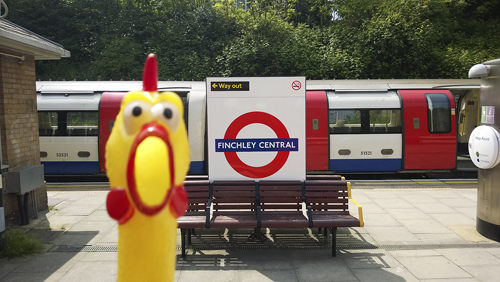
Finchley Central was recorded as Finchelee-leya c. 1208 and it is possible that the name is derived from what can be interpreted as a finch clearing (meaning the bird) and the Old English leah, ’a forest’ – ’the clearing in the forest with the finches’. More likely the word is from a personal name, Finc – meaning ’Finc’s Forest’. The name has many spellings and was recorded as Fyncheley in 1547.
The station was opened by the Great Northern Railway as Finchley & Hendon on 22 August 1867; it became Finchley (Church End) on 1 February 1894 and Finchley Central on 1 April 1940. It was first used by Underground trains on 14 April 1940.
FINCHLEY ROAD
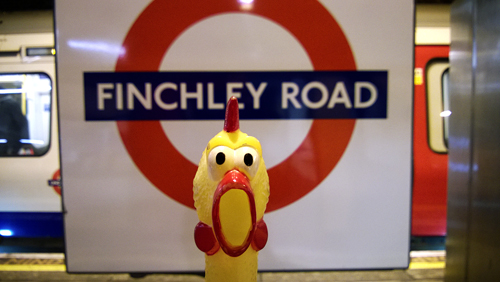
In 1827 an Act of Parliament was passed to build a new road out of London to Barnet, to avoid the hills of Hampstead and Highgate. This road was planned by way of Finchley – hence the name.
The station was opened as Finchley Road on 30 June 1879.
FINSBURY PARK
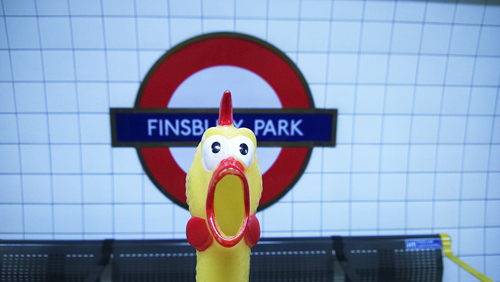
Finsbury Park is on the site of the earlier Hornsey Wood. The Park, opened in 1869, was so called because the inhabitants within the old Parliamentary borough of Finsbury initiated a movement for its acquisition, which all seems very curious since it is far from Finsbury, which is near central London. Finsbury itself was recorded as Vinisbir in 1231 and this is the most likely to have been derived from an Anglo-Scandinavian name Fin, and the Old English burgh, ’manor’ – and thus means ’Fin’s Manor’. It was recorded as Fenusbury in 1535.
The station was opened by the Great Northern Railway as Seven Sisters Road on 1 July 1861. It was re-named Finsbury Park in 1869 and first served by the Piccadilly Line on 15 December 1906.
FULHAM BROADWAY
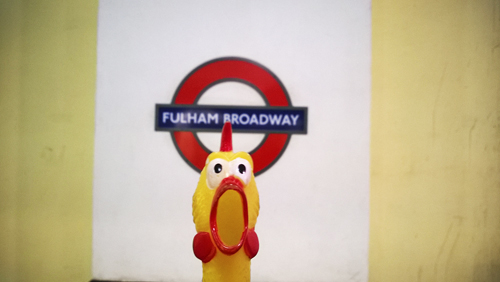
The manor of Fulanham is recorded as early as 691. There has been much speculation about the origin of the name, two explanations being foul-town on account of its muddy ways near the river, or fowl-ham – being the haunt of wild-fowl. Both of these explanations can now be discounted. It is more likely that Fulham is derived from the personal name Fulla and the Old English hamm, ’a water meadow’, being descriptive of the low-lying bend in the River Thames at this point – ’The Meadow where Fulla lives’, referring to an early Saxon and his family. It has had many changes in spelling and was recorded as Fullam in 1533.
The station was opened as Walham Green on 1 March 1880; re-named Fulham Broadway 2 March 1952.
GANTS HILL

Gants Hill was recorded as Gantesgave in 1291 and the name may well be associated with the family on Richard le Gant.
At the planning stage of the New Works Programme 1935/40, the station was referred to as Ilford North, Cranbrook was suggested as an alternative, as was Gants Hill which was not liked by the New Works Committee. However, the station opened as Gants Hill on 14 December 1947.
GLOUCESTER ROAD
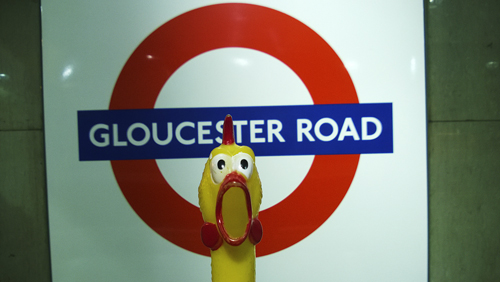
Gloucester Road was known as ’Hog moore lane’ as late as 1858 and at this time was probably descriptive of a muddy tract. Was re-named in the early 19th century after Maria, Duchess of Gloucester, who lived in the road at the turn of the century.
The station was opened as Brompton (Gloucester Road) on 1 October 1868; re-named Gloucester Road 1907.
GOLDERS GREEN
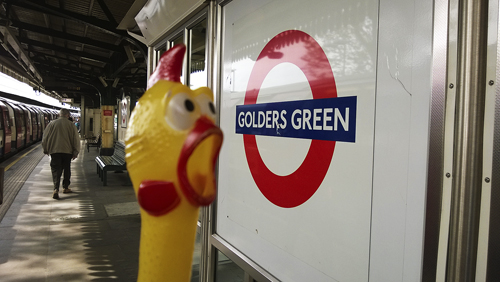
Golders Green was recorded in 1612 and Golder seems clearly to refer to a personal name although no such recorded name has been noted in the early history of the parish. It seems that the name should be associated with John le Godere in 1321 and John Godyer of Hendon in 1371 and it may well be that Golders is a corruption of the later name. It is also suggested that Godyer was an obscure farmer who in fact sold his property and left the district. The Green was once part of the fields of Middlesex, which remained rural until the arrival of the railway.
The station opened as Golders Green on 22 June 1907.
GOLDHAWK ROAD
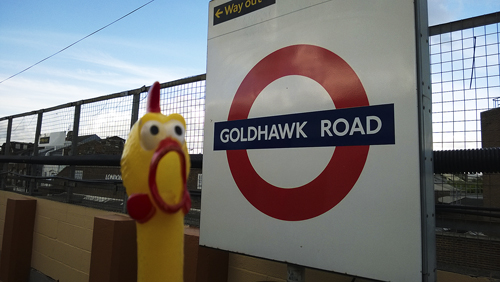
Goldhawk Road was Gould Hawk Lane in 1813 and maybe the road should be associated with a family named Goldhawk(e) of the 15th century, for the name is frequently mentioned in ’Court Rolls’ of this time. There was also a Goldhauek living in nearby Chiswick as early as 1222.
The station was opened as Goldhawk Road on 1 April 1914.
GOODGE STREET
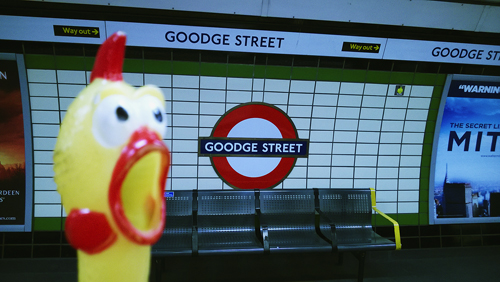
Goodge Street was once called ’Crab tree field’, being a meadow belonging to a widow named Mrs Bedford who married a Marylebone carpenter, John Goodge c. 1718. When the street was built c. 1770 the name was taken from William and Francis Goodge who then owned the site.
The station was opened as Tottenham Court Road on 22 June 1907; re-named Goodge Street 9 March 1908.
GRANHE HILL
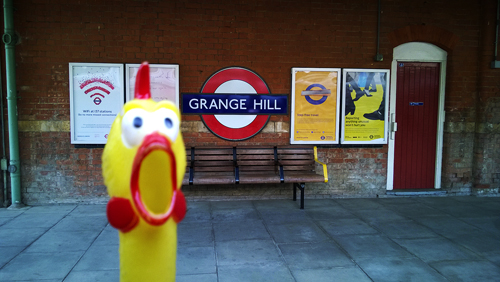
The Grange was one of the manors originally belonging to Tilty Priory. After the dissolution of the monasteries it was granted in 1537 to Thomas Adlington. It changed hands many times until the manor was as an endowment to Brentwood Grammar School in 1558. The School retained the property until the late 19th century when the land was sold and the building demolished. The Hill is the road at the front of the station.
The station was opened as Grange Hill by the Great Eastern Railway on 1 May 1903 and was first used by Underground trains on 21 November 1948.
GREAT PORTLAND STREET
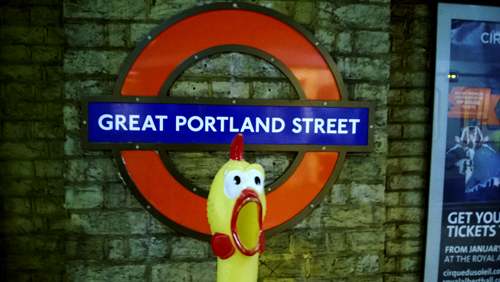
In 1710 the manor of Marylebone was bought by the Duke of Newcastle, but by 1734 it passed to the Second Duke of Portland. When the street was built in the late 18th century it was so named in honour of the Duke, the northern part being known as Portland Road, which was recorded in 1793. The prefix Great does not indicate the importance of the street itself but that there are smaller streets of the same name in the neighbourhood.
The station was opened as Portland Road on 10 January 1863 and re-named Great Portland Street 1 March 1917.
GREENFORD
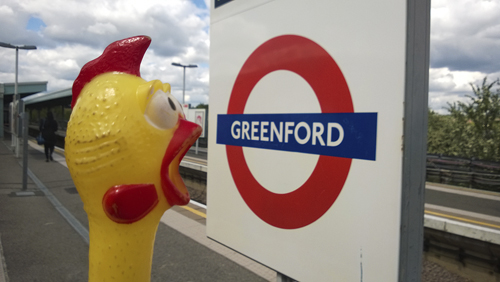
Greenford was recorded as grenan forda in 875 and as Greneford in the Domesday Book. As the name suggest, it refers to a ford, which was a crossing place over the River Brent which led to a green.
The station was opened as Greenford by the Great Western Railway on 1 October 1904. A new station for Underground trains was opened on 30 June 1947.
GREEN PARK
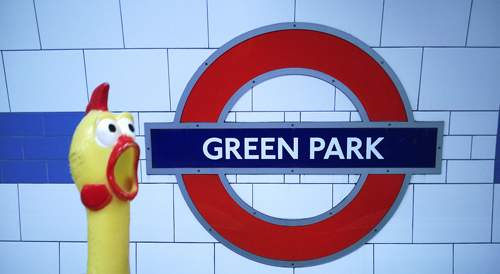
Green Park was created in 1668 and extends north from the Mall and Constitution Hill to Piccadilly. It is 53 acres in size and triangular in shape. Originally added to the Royal Parks by Charles II, it replaced St James’s Park as the fashionable resort of society. Reduced in size by George III in 1767 to enlarge the gardens of Buckingham Palace, it was then known occasionally as Upper St James’s Park. The name seems to have been derived from the grass that ’grew all around’.
The station was named as Dover Street on 15 December 1906 and re-named Green Park with a re-sited entrance in Piccadilly and next to the park 18 September 1933.
GUNNERSBURY
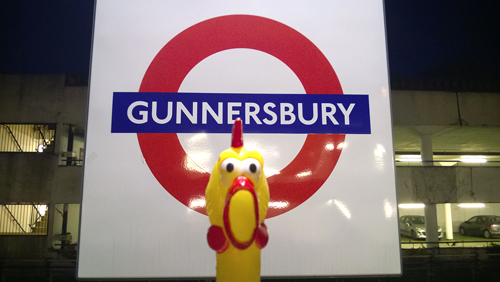
Tradition has it that on a site near here stood the dwelling of Gunhilda (or Gunyld) the niece of the Danish King Canute (reigned 1016–35) but this seems to rest on unsupported evidence. Recorded as Gounyldebury in 1334 its name seems to be derived, nevertheless, from a female name of Scandinavian origin – Gunnhild’s (or variations) and the Old English burh, ’a manor’. It was recorded as Gunsbury in c. 1651.
The station was opened by the London & South Western Railway as Brentford Road on 1 January 1869 and re-named Gunnersbury on 1 November 1871. First used by Underground District and Metropolitan trains on June 1877, the Metropolitan Railway’s trains until 31 December 1906.
HAINAULT
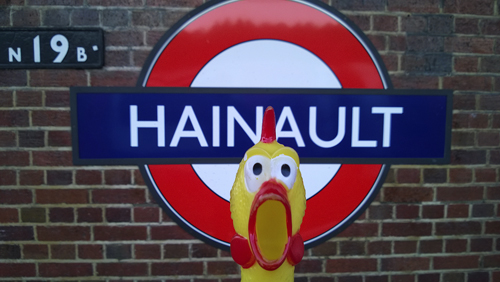
Hainault is not French origin as it may seem, but is a corruption of the earlier name Hyneholt. In this turn this is derived from the Old English hiwan, ’a household’ and holt, ’a wood’ (or hale ’ a nook of land’) – means ’the household on the land with a wood’. The household probably refers to a local religious community. The modern spelling seems to arise from a fictitious connection with a Philippa of Hainault.
The station was opened as Hainault by the Great Eastern Railway 0n 1 May 1903. First used by Underground trains (after reconstruction) on 31 May 1948.
HAMMERSMITH
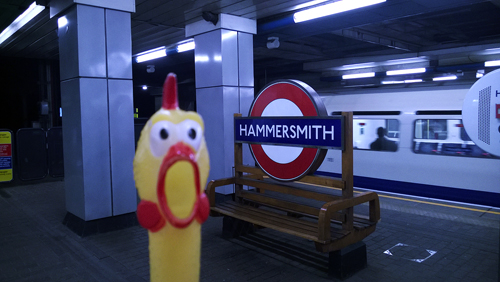
Hammersmith was recorded as Hammersmyth in 1294 and was a hamlet within Fulham until 1834. The origin of the name is in doubt. Some suggest that it is derived from Old English ham, ’a home’ or ’town’ and hythe, ’a port’ – ’the home by the port’, referring to its location on the Thames. More likely it comes from (again Old English) hamor, ’hammer’ and smydde, ’a smithy’ – referring to a local blacksmith who once lived here. It was recorded as Hammersmith in 1675.
The Hammersmith & City Line station was opened as Hammersmith on 13 June 1864, and re-sited farther south on 1 December 1868. The District Line station was opened as Hammersmith on 9 September 1874.
HAMPSTEAD
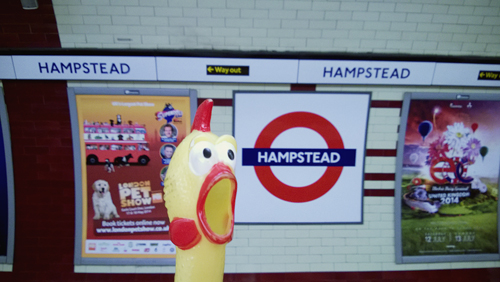
Hampstead is a name simply meaning being derived from Old English ham, ’a home’ and stede, ’a site’ – meaning, literally ’the home-site’, and probably refers to a farm-site. Recorded as Hemstede in the 10th century and Hamstede in the Domesday Book.
Prior the station’s opening the name Heath Street was proposed, but the station opened as Hampstead on 22 June 1907.
HANGER LANE
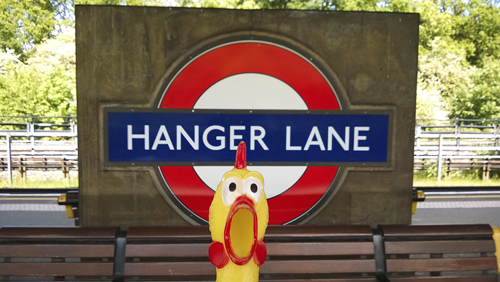
Hanger Lane was named Hanger Hill in 1710 and marks the site of wood recorded as le Hangrewode in 1393 and is derived from the Old English hangra ’a wooded hill’, with clinging steep slopes, later changed to Lane.
The station was opened as Hanger Lane on 30 June 1947.
HARLESDEN
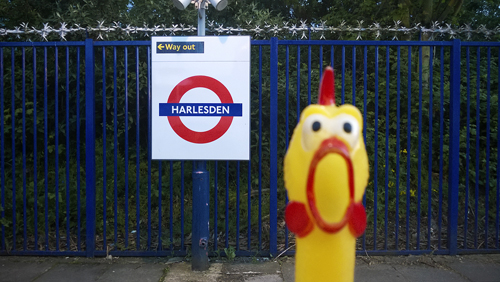
Harlesden was recorded as Herulvestune in the Domesday Book and comes from the personal name of the Saxon Heoruwulf (or Herewuff) and Old English tun, ’a farm’ – means ’Heoruwulf’s farm’, being on the site where he and his family once lived. It was recorded as Herlesdon in 1291.
The station was opened as Harlesden by the London & North Western Railway on 15 June 1912 and first used by Underground trains on 16 April 1917.
HARROW & WEALDSTONE

See Harrow-on-the hill for Harrow. Wealdstone was Weald Stone in 1754 and the name probably derives from the Old English weald, ’a forest’, indicating that the land here was once covered by the heavy Middlesex woodlands, and a ’boundary stone’. A ’stone’, three feet tall, still stands outside the ’Wealdstone Inn’ but it is doubtful if this is the original one. We may assume that Wealdstone means ’the boundary stone in the forest’. The growth of this place dates from the opening of the London & Birmingham Railway.
The station was opened by the London & Birmingham Railway as Harrow on 20 July 1837. It was re-named Harrow & Wealdstone on 1 May 1897 and first used by Underground trains on 16 April 1917.
HARROW-ON-THE-HILL
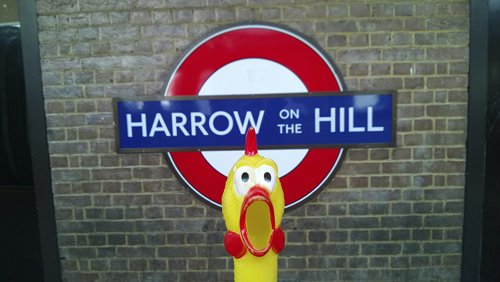
The history of Harrow reminds us of the times before Christianity ousted paganism from England, for the name is derived from the Old English hearg, ’heathen temple or shrine’. Harrow is a prominent isolated hill rising about 300 feet above the Middlesex plain and here, perhaps on the site of the present church, must have stood a temple (or idol) of ancient heathen worship. It was recorded as Hergas in 832 and Herges in the Domesday Book but had changed to Harowe by 1369. There is an earlier name referring to Gumeninga; this may be tribal people who were pagans, but nothing is really known. Harrow is famous for its public school.
The station was opened as Harrow on 2 August 1880, and re-named Harrow-on-the-Hill on 1 June 1894.
HATTON CROSS
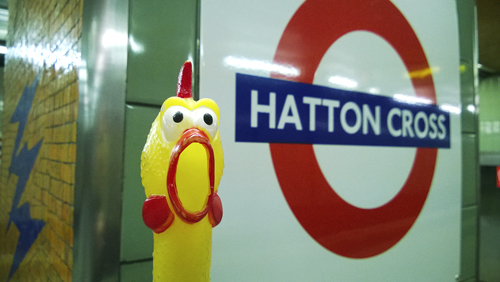
Hatton Cross was recorded as Hatone in 1230 and is derived from the Old English haep, ’heath’ and tun, ’a farm’ – and means ’the farm on the heath’. The cross may have some reference to an old bouldary mark, but more convincingly a reference to the road junction.
The station was opened as Hatton Cross on 19 July 1975.
HEATHROW (TERMINALS 1,2,3, TERMINAL 4 and TERMINAL 5)
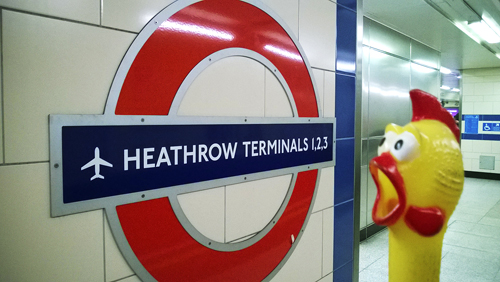
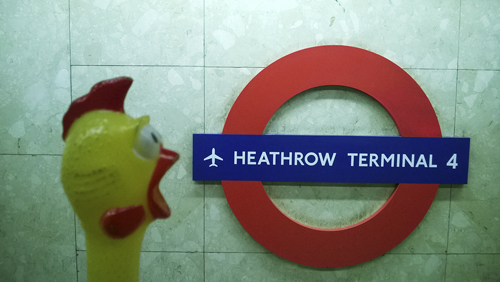
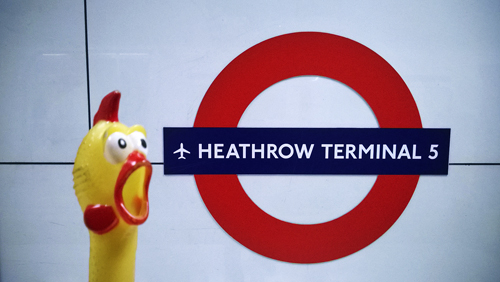
Heathrow was recorded as Hetherewe in 1547 and was, perhaps, the home of John atte Hethe who lived there in the 14th century. The name is probably derived from the Old English heap, ’heath’ and raew, ’row’ – ’the row of houses in the heath’. Alternatively, the second half of the name may derive from the Old English word ruh which means ’rough or uncultivated ground’, and perhaps Heathrow was originally ’the rough heath’. It now houses one of the world’s busiest airport.
Heathrow terminals 1,2,3 was opened as Heathrow Central on 16 December 1976, which was changed to Heathrow Central Terminals 1,2,3 on 3 October 1983 and gained its present name on 12 April 1986. Heathrow Terminal 4 station was opened on 12 April 1986.
Heathrow Terminal 5, opened 27 March 2008, is the only Underground station owned by BAA, the airport company.
HENDON CENTRAL
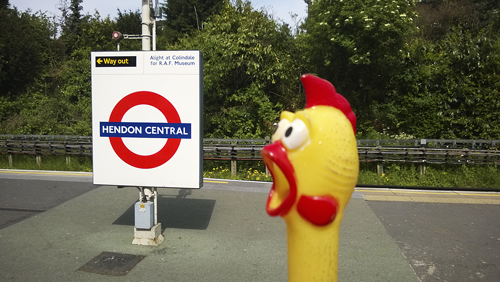
Hendon was recorded as Hendun c. 959 and as Handone in the Domesday Book. The name is derived from the Old English haeh, ’high’ and dun, ’down or hill’ – and means ’at the high hill’, referring to the old village of Hendon clustered round the church of St Mary, atop a high hill.
The station was opened as Hendon Central on 19 November 1923.
HIGH BARNET
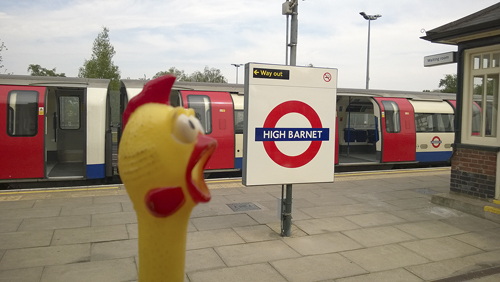
High Barnet was recorded as Barneto c. 1070 and as la Bernet in 1235 and is derived from the Old English baernet – ’a place cleared by burning’ – or bernette, a French word for slope – i.e. Barnet Hill. Ground was cleared this way by early settlers. High refers to its geographical location.
The station was opened as High Barnet by the Great Northern Railway on 1 April 1872 and first used by Underground trains on 14 April 1940.
HIGHBURY & ISLINGTON
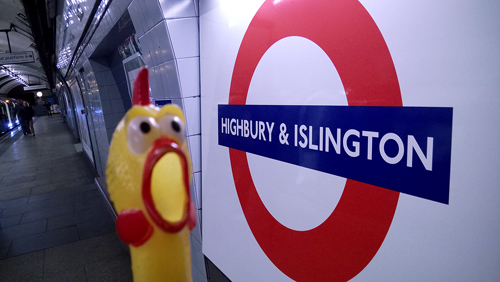
Originally Highbury was a summer camp of the Romans and during the 13th century the Priory of St John on Jerusalem had a manor here that was destroyed in 1381. Recorded as Heybury during the 14th century, the name is derived from high and the Old English burh, ’the manor on high ground’, as opposed to nearby Canonbury and Barnsbury which stand lower ground. Islington, recorded as Gislandune c. 1000 and Isendone in the Domsday Book, is derived from: 1. the personal name Gisla and the Old English dun, ’hill or down’ – ’Gisla’s hill’ referring to a Saxon and his family who once lived on a site here, or 2. the Old English Gisel, ’a hostage’ and dun, ’hill’ – indicating that hostages were once held here, or 3. Old English Isel, ’lower’ and don – which can be interpreted as meaning ’a fortified enclosure’. It was recorded as Islyndon in 1554.
The station was opened as Highbury on 28 June 1904 and re-named Highbury & Islington on 20 July 1922.
HIGHGATE
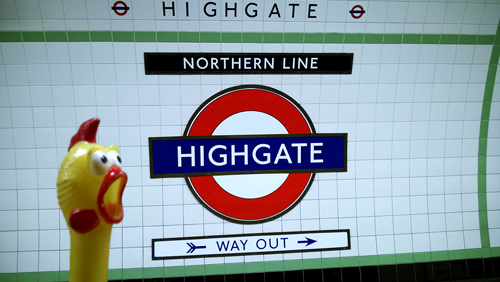
From very early times tolls were collected from travellers who used the Bishop of London’s road across his park at Hornsey which led to Finchley. This was at the High Gate (Le Heghgate recorded in 1354) which gave its name to the hamlet and later village at one of the highest points in London.
The station was opened as Highgate by the Great Northern Railway on 22 August 1867, and first used by Underground trains on 19 January 1941. (See also Archway.)
HIGH STREET KENSINGTON
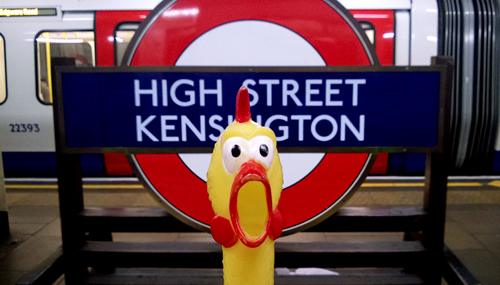
For centuries two roads, both Roman in origin, one following the lines of the High Street, were the only means of east-west communication in this part of London. The first building in the vicinity took place during the reign of Charles II (1660–85) to the south of the present street, while the north side was built up during the 1780s. More development took place in the early 19th century, followed shortly afterwards by the arrival of the famous shops of the street.
Prior the station’s opening it was often referred to as Kensington, but it was opened as High Street Kensington on 1 October 1868. (See also Kensington Olympia.)
HILLINGDON
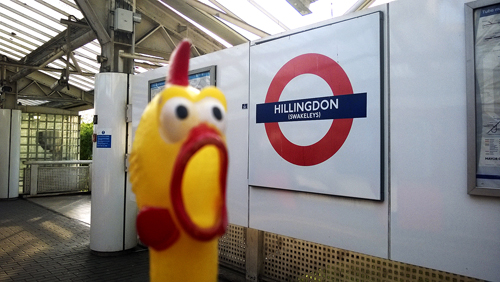
Hillingdon was recorded as Hildendun in 1078 and the name is derived from the personal name Hilda and the Old English dun, ’hill’ – and thus means ’Hilda’s Hill’ referring to a Saxon family who once lived here. It was recorded as Hilendon in 1254.
The station was opened as Hillingdon on 10 December 1923.
HOLBORN
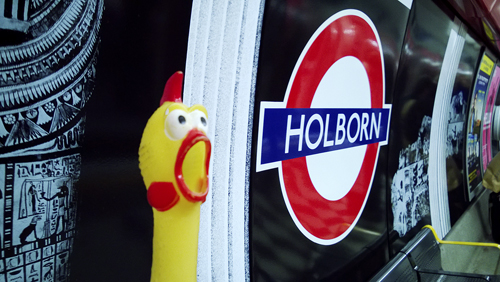
Holborn was recorded as Holeburne in 951 and takes its name from part of the River Fleet. It is derived from the Old English holh, ’a hollow’ and burna, ’a steam’ – means ’the steam (or brook) in the hollow’. The hollow is the valley now spanned by Holborn Viaduct. Kingsway is the street that runs from Holborn station to Aldwych, and was begun in 1901 to clear the slums of this area. It was opened by Edward VII in 1905. There was some controversy over the choice of name but finally Kingsway was chosen, no doubt for patriotic reasons.
The station was opened as Holborn on 15 December 1906 for the Piccadilly line. The Central Line platforms (replacing British Museum station) were opened on 25 September 1933.
HOLLAND PARK
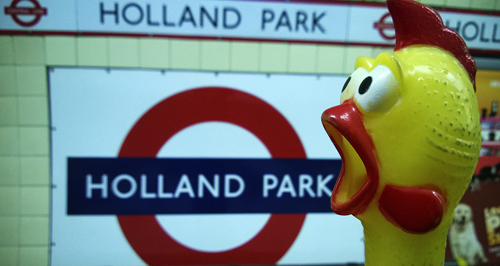
In the park is Holland House, a historic Jacobean mansion begun in 1605 and attributed to John Thorpe, which was originally called Cope’s Castle as it was built for Sir Walter Cope. The house passed by marriage to Sir Henry Rich, who was created Earl of Holland in Lincolnshire in 1624, and who gave his name to the house and park. The whole estate was sold to the London County Council in 1952.
Prior the station’s opening the name of Lansdown Road was considered, but it opened as Holland Park on 30 July 1900.
HOLLOWAY ROAD
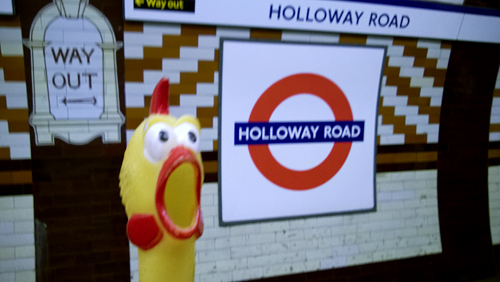
Holloway Roan is a common road name and as it may suggest means ’the way in the hollow’. The road name later became the name of the district. The hollow refers to the fact that the hamlets of this area were situated on rather low-lying ground between Highgate and Islington; called le Holeweye in 1307.
Early plans show the station’s name as plain Holloway, but it was opened as Holloway Road on 15 December 1906.
HORNCHURCH
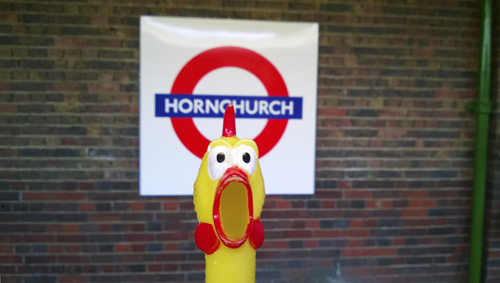
From ancient records there is a reference (in 1222) to the horned church (or monastery) in this district. Nothing of the monks’ first church survives today, but the present building contains a bull’s head and horns affixed to the east end, which has been since at least 1610. The reason for this is rather obscure. It is possible that it could be a reference to a seal of a French monastery or that it could be a reference to the tanning industry which once flourished in this area.
The station was opened as Hornchurch by the London, Tilbury & Southend Railway on 1 May 1885, and was first used by Underground trains on 2 June 1902.
HOUNSLOW CENTRAL
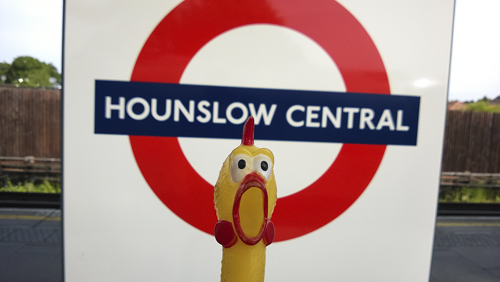
Hounslow was recorded as Honeslaw in the Domesday Book and is derived from the Old English personal name Hund and hlaw, ’a hill’ – means ’the hill where Hund lived’. It has no connection with dogs (unlike Houndsditch) as the name may suggest. It was recorded as Haunslawe in 1252.
The station was opened as Heston Hounslow on 1 April 1886; second station opened 19 October 1912; re-named Hounslow Central 1 December 1925.
HOUNSLOW EAST
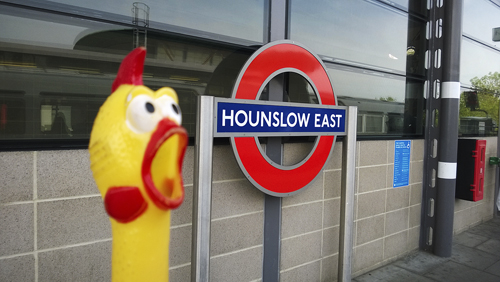
See Hounslow Central.
The first station (on a spur line) was opened on 1 May 1883 as Hounslow; re-named Hounslow Town in 1884. It was closed on 31 March 1886; re-opened an 1 March 1903, and finally closed on 1 May 1909. A new station (on the main line) was opened on 2 May 1909 and re-named Hounslow East 1 December 1925.
HOUNSLOW WEST
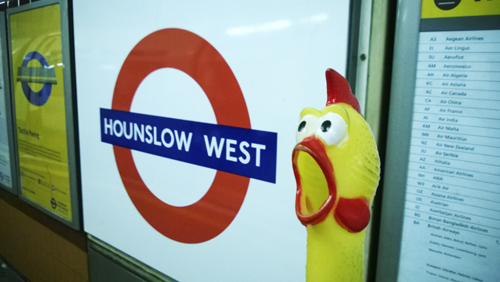
See Hounslow Central.
The station was opened as Hounslow Barracks 21 July 1884; re-named Hounslow West 1 December 1925. The new station opened 11 December 1926.
HYDE PARK CORNER
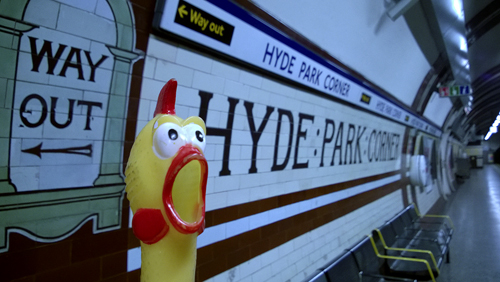
A name that occurs frequently both in the Domesday Book and in place-names is hide, which has been described as ’a piece of ground sufficiently large and fertile to maintain an ordinary household’. Hyde Park was name after a hide of land belonging to the Manor of Ebury, for at about the time of the Domesday Book the manor was divided into three smaller parts, one being called Hyde. From the time of the Norman Conquest until the Dissolution (1066–1536) the Hyde was in the possession of Westminster Abbey. It was then taken by Henry VIII and converted into a royal deer-park. In 1635 Charles I opened it to the public. The Corner was the entrance to London until 1825 when the turnpike was removed. It now consists of an triangular space, enlarged in 1888 when a portion of nearby Green Park was taken for the roadway.
The station was opened as Hyde Park Corner on 15 December 1906.

